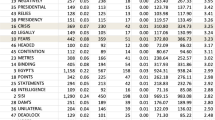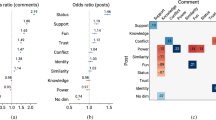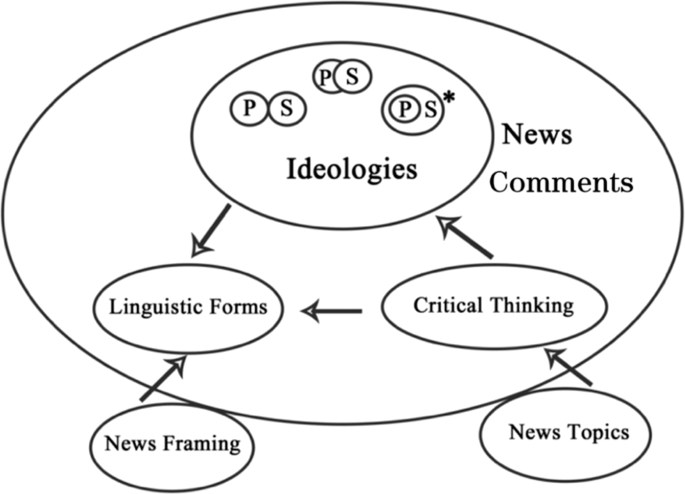
This study explores linguistic features, ideological beliefs, and critical thinking in news comments, which are defined as the comments from readers to news posts on social media or platforms. Within the overarching framework of critical discourse analysis, a sociocognitive approach was adopted to provide detailed analyses of the studied constructs in sampled news comments. In terms of the data collection and analysis, sampled social media, news columns, and news comments were selected, and then 19 college students were interviewed for their responses to different news topics. The primary findings of the study include: (1) personal and social opinions are representations of ideological beliefs and are fully presented through news comments, (2) these personal and social ideological beliefs may diverge or converge due to critical thinking, (3) critical thinking helps commenters form their personal and social ideologies, and then helps them choose the linguistic forms they believe fit their news comments, (4) news topics, however, vary in informing commenters’ critical thinking ability. Finally, a sociocognitive model for studying linguistic forms, ideologies, and critical thinking was proposed in the study.



Over the decades, the majority of the existing literature on news text has focused on how the news is framed from an author’s perspective; however, research on news text from commenters is far less developed. Therefore, we chose a specific type of underdeveloped news text, i.e., news comment, as the focal text for this study. In the study, news comments were not defined as the long commentary articles professionals or journalists write to comment on specific news; instead they were the real-time, short comments or prompts from readers. We took the theoretical premise from van Dijk (1997) that news text is ideological in nature (p. 197) and explored how critical thinking and linguistic forms, as different constructs, may inform the commenters of revealed ideologies through a specific news text. Before we elaborate on the theoretical framework, we present some synopses of the terms or constructs, i.e., ideology and critical thinking, the focal components of the study.
Van Dijk (2006) defined ideologies as “systems of ideas” and sociocognitively “shared representations of social groups, and more specifically as the axiomatic principles of such representations” (p. 115). Ideologies are thus “the basic frameworks for organizing the social cognitions shared by members of social groups, organizations or institutions” (van Dijk, 1997, p. 18) and penetrate all discourse and communication, including media text as one of the predominant forms. From a critical literacy perspective, Tolson (2001) argued that the informational content conveyed through the mass media is ideology-based; it reproduces and strengthens social relations between the oppressed and the oppressors. Therefore, news commentary, as one type of media text, shows the audience’s attitudes towards a particular news, topic, or event; it conveys the ideological beliefs that audiences hold about the news, topics, or events. Fairclough (2006) argued that understanding how audiences interpret and respond to the news is helpful to analyze their ideologies. However, the explicitness or vagueness of the ideological beliefs revealed through media discourse or news text makes research on this topic difficult.
Ideologies include cognitive and social ideologies and these two types of ideologies may converge or diverge. We argue that the convergence or divergence of these two types of ideologies depends on critical thinking, another construct that we explore in the study. The notion of critical thinking may be traced to different fragmented tenets of critical discourse analysis (CDA). At the same time, it is one of the core components in interpreting discourse and text (Fairclough, 2006). Critical thinking is related to the notion of reflexivity in some classic CDA works; it may refer to both a general principle of doing scientific research and a property of language use, subjectivity, or practice (Chouliaraki and Fairclough, 1999; Feustel et al., 2014; Zienkowski, 2017). For example, Fairclough (2010) stated that
“Late modernity is characterized by increasing reflexivity including language reflexivity, and people need to be equipped both for the increasing knowledge-based design of discursive practices within economic and governmental systems, and for critique and redesign of these designed and often globalized practices” (p. 603).
Multiple approaches have been used to study linguistic features, ideologies, and critical thinking. Studying these constructs is a challenging task. Because the complex world is dynamic and changes regularly, a specific and individual framework may not be able to interpret or explain the constructs thoroughly. Furthermore, some the focal components or tenets of some theories or frameworks may overlap, which complicates the selection of a theoretical framework. For the current study, we decided to pinpoint our focal constructs and then align these constructs with appropriate theories. While CDA has been applied to studies on language and ideology for decades, it has rarely been considered with regard to news comments, particularly in the Chinese context. This research thus aims to study the linguistic features of news comments through major social media in China and to further explore ideological and critical thinking incidents in these commentary responses. Specifically, we attempt to explore the following issues: (1) the typical linguistic forms, ideologies, and critical thinking in news comments and (2) how these constructs inform each other in news comments.
Under the overarching concept of CDA, different focal approaches or schools have developed over the years, including but not limited to: Fairclough’s Critical Approach, Wodak’s Discourse-historical Approach, and van Dijk’s sociocognitive approach (SCA). Fairclough’s approach has been regarded as the foundational and most classic approach. It perceives language as a social process in which discourse produces and interprets text; however, this process is not random or free but is socially conditioned. Fairclough’s approach has infrequently focused on media text, which then has been extended and developed by Wodak and van Dijk. Unlike Fairclough’s approach, Wodak’s approach focuses on a macroperspective as national identity and is concerned with strategies that can be adapted to achieve specific political and psychological goals. To understand this bigger picture, Wodak’s approach includes historical analysis and considers the sociocultural background of the text studied. In terms of media text study, Wodak and Busch (2004) analyzed different approaches in media text, from mapping out historical development in CDA to advanced qualitative approaches in critical linguistics and CDA.
SCA resembles Fairclough’s approach in connecting the microstructure of language to the macrostructure of society (Kintsch and van Dijk, 1978). However, van Dijk (1993) extended the field by transplanting social cognition as the mediating tool between text and society. He defined social cognitions as “socially shared representations of societal arrangements, groups, and relations, as well as mental operations such as interpretation, thinking and arguing, inferencing and learning” (p. 257). Similar to Wodak, van Dijk (1991) applied his approach of discourse analysis to media texts and firmly believed that one area in which discourse can play an important role is in the (re)production of racism inequality through discourse. The major point of his work is that “racism is a complex system of social and political inequality that is also reproduced by discourse” (van Dijk, 2001, p. 362). Van Dijk’s SCA thus focuses on the schemata through which minorities are perceived and illustrated as well as in headlines in the press.
We firmly believe that no single approach mentioned above perfectly fits all the constructs to be studied in the research, but tenets of different approaches work in different ways to inform the findings of the study. We went deeper into these frameworks and determined that an SCA approach under CDA may better inform the study and thus serve as the theoretical foundation of the study; it works better than other approaches in mapping out relationships among language, cognition in which critical thinking is embedded, and ideologies. However, we did not adhere to a specific school or approach in CDA but instead incorporated different tenets among three different schools in CDA into our study. For example, we referred to a textual analysis perspective from the three-dimensional framework (Fairclough, 1995) and extended and interpreted our findings by incorporating social and national ideologies from Wodak (2007) and social/personal cognition from van Dijk (1997).
In addition, we reinterpreted CDA from an audience or commenter perspective rather than the author perspective. Our rationale is that the text an author or speaker has framed may serve discursive and social purposes. The author or speaker in this way serves as the initiator of the discursive and social practices. However, this is not the case from an audience or reader perspective. An audience or reader is not the initiator of the actions or practices; he or she may be the person who accepts or rejects the practices. Therefore, we argue that examining ideological and critical thinking constructs in news comments may reveal audiences’ perceptions of and attitudes towards certain practices and even the power behind these practices.
Wodak and Meyer (2015) concluded that “CDA does not constitute a well-defined empirical method but rather a bulk of approaches with theoretical similarities and research questions of a specific kind” (p. 27). They further explained that methodologies under CDA typically fall into a hermeneutic rather than an analytical-deductive approach. The hermeneutic style requires detailed analyses and reasoning that fit the theoretical framework in the study.
While it might be a challenging task to pinpoint a specific methodology, we followed appropriate guidance in conducting this CDA study. As classic methodological guidance, Wodak and Meyer (2015) provided a diagrammed process for conducting CDA studies, including theory, operationalization, discourse/text, and interpretation. Theories provide the soil for the conceptualization and selection of theoretical frameworks; operationalization demands specific procedures and instruments; discourse/text is a platform to convey the information; and interpretation is the stage to examine assumptions. One of the major components that guide the methodological design and selection is operationalization, which requires specific procedures and instruments. Therefore, we first selected social media and sampled news and then conducted interviews among 19 college students in a typical research-based university in Northeast China.
Liu (2019) synthesized social media user reports in the first quarter of 2018 and listed the top 10 social media software and apps that people used in China, which included payment apps (e.g., Alipay), shopping platforms and/or apps (e.g., Taobao), and other platforms and/or apps for entertainment or regular social purposes (e.g., WeChat, Baidu, Sina). According to the poll, we selected WeChat (1040 million users), Baidu search (700 million users), and Sina vlog (392 million users) as the three social media we used for the current study.
Among the three largest social media platforms, Baidu News has a specific classification of 12 news columns, which include domestic affairs, international affairs, military and army, finance and economics, entertainment, sports, internet, technology, gaming, and beauty. The column military and army was an outlier in the selection because it is heavily political or ideological in the context; gaming and beauty were also regarded as two outliers that were highly gender-oriented. After a screening process, we thus deleted and synthesized these columns into six, including domestic/international affairs, finance, entertainment, sports, technology, and game.
Then, one or two news samples were selected under each topic, considering whether the samples might solicit rich information from the interviewees or commenters. For analysis purposes, we collected representative responses with high recognition of the selected news samples. We then conducted a rough analysis of the selected news and corresponding comments and discussed the appropriateness of the news samples. We finalized 12 sampled news items with more than 30 comments and charted them in Table 1.

By mapping out different comments, we find that critical thinking works as an analytical and filtering tool to guide commenters to select their ideological beliefs, either personal or social. These personal and social ideological beliefs may diverge or converge. The divergence or convergence of personal and social ideological beliefs may indicate the strength of critical thinking, which, however, may not equal the quality of critical thinking. To be more specific, critical thinking may help commenters present a different perspective from the commonly accepted social perspective, which shows efforts in analyzing a news article and offering their opinions. However, the opinions that differ from widely accepted views may not be weighed as right or wrong or un/acceptable; they may just be different voices.
We argue that these personal and social opinions are representations of ideological beliefs and are fully presented through news comments; news comments are ideology-based. Critical thinking helps commenters choose their personal and social ideologies and then helps them choose linguistic forms they believe fit their news comments. While critical thinking plays a crucial role in choosing specific ideological beliefs and linguistic forms, news topics vary in informing commenters’ critical thinking ability. In the study, we found that some topics may inform divergence between personal and social ideological beliefs, whereas other topics may inform the convergence of the two constructs. We also propose that the way a specific piece of news is framed informs the linguistic form of the news comments, which may arouse a certain sense in the commenters (e.g., a sense of belonging as in/out-group members). Reading these news pieces may stimulate commenters’ critical thinking and then work on the linguistic forms in news comments.
The present study provided an overall account of how linguistic features, ideological beliefs, and critical thinking accounts are revealed through news comments. News comments in China present value propositions and ways of thinking through complex lexical and syntactical structures. The respondents presented power, ideology, inequality, and social justice through their responses to the news, which informed news commentary as a way to serve the social function of the language. The responses also presented the younger generation’s personal ideology through the news comments. However, topics were important in informing these constructs and caused divergences among different comments. One of the critiques that this study, and the CDA studies in general, may receive is the simplistic or even vague description of the methodology (Wodak, 2006) because there is currently “no accepted canon of data collection” (Wodak and Meyer, 2015). Instead, we tried to provide careful systemic analysis and separated description and interpretation (Wodak and Meyer, 2015). For future studies, we believe that further analysis of how critical thinking may work with personal and social ideologies is necessary. Additionally, it is worthwhile to study the effects of other cognitive attributes on language and ideologies to extend the SCA domain.
The data analyzed and generated are included in the paper.
The paper is funded through Graduate Program Research Fund (# YJG2020403) at Dalian Maritime University. In addition, it is also partially funded through DMU Xinhai Scholar Research Fund (#02500805). Our sincere thanks go to our undergraduate and graduate students who were keen on helping us with data collection and analysis.